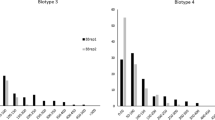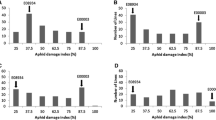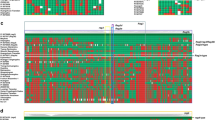Abstract
The soybean aphid (Aphis glycines Matsumura) is an important pest on soybean [Glycine max (L.) Merr.] in North America. Aphid resistance has recently been found on plant introduction (PI) 567543C, but little is known about its genetic control. The objectives of this study were to identify the resistance genes in PI 567543C with molecular markers and validate them in a different genetic background. A mapping population of 249 F4 derived lines from a cross between PI 567543C and a susceptible parent was investigated for aphid resistance in both the greenhouse and the field. The broad sense heritability of aphid resistance in the field trial was over 0.95. The segregation of aphid resistance in this population suggests a major gene controlling the resistance. Bulked segregant analysis with molecular markers revealed a potential genomic region. After saturating this putative region with more markers, a genetic locus was mapped in an interval between Sat_339 and Satt414 on chromosome 16 (linkage group J) using the composite interval mapping method. This locus explained the majority of the phenotypic variation ranging from 84.7% in the field trial to 90.4% in the greenhouse trial. Therefore, the aphid resistance in PI 567543C could be mainly controlled by this gene. This aphid resistance gene was mapped on a different chromosome than the other resistance genes reported previously from other resistant germplasms. This gene appears to be additive based on the aphid resistance of the heterozygous lines at this locus. Thus, a new symbol Rag3 is used to designate this gene. Moreover, Rag3 was confirmed in a validation population. This new aphid-resistance gene could be valuable in breeding aphid resistant cultivars.


Similar content being viewed by others
References
Bell-Johnson B, Garvey G, Johnson J, Lightfoot D, Meksem K (1998) Biotechnology approaches to improving resistance to SCN and SDS: methods for high throughput marker assisted selection. Soyb Genet Newsl 25:115–117
Churchill GA, Doerge RW (1994) Empirical threshold values for quantitative trait mapping. Genetics 138:963–971
Clark AJ, Perry KL (2002) Transmissibility of field isolates of soybean viruses by Aphis glycines. Plant Dis 86:1219–1222
Cregan PB, Quigley CV (1997) Simple sequence repeat DNA marker analysis. In: Caetano-Anolles G, Gresshoff PM (eds) DNA markers: protocols, applications and overviews. Wiley, New York, pp 173–185
Davis JA, Radcliffe EB, Ragsdale DW (2005) Soybean aphid, Aphis glycines Matsumura, a new vector of potato virus Y in potato. Am J Potato Res 82:197–201
Desneux N, O’Neil RJ, Yoo HJS (2006) Suppression of population growth of the soybean aphid, Aphis glycines Matsumura, by predators: the identification of a key predator and the effects of prey dispersion, predator abundance, and temperature. Env Entomol 35:1342–1349
Fehr WR (1987) Principles of cultivar development: theory and technique. MacMillan, New York
Fehr WR, Caviness CE (1977) Stages of soybean development. Special Report, Agriculture and Home Economics Experiment Station, Iowa State University, 1977, issue 80, p 11
Fletcher MJ, Desborough P (2000) The soybean aphid, Aphis glycines, present in Australia. http://www.agric.nsw.gov.au/hort/ascu/insects/aglycin.htm. Accessed 2 Jan 2009
Fox TB, Landis DA, Cardoso FF, Difonzo CD (2004) Predators suppress Aphis glycines Matsumura population growth in soybean. Env Entomol 33:608–618
Grant D, Imsande MI, Shoemaker RC (2009) SoyBase, The USDA-ARS soybean genome database. http://soybase.agron.iastate.edu. Accessed 24 Feb 2009
Gregg AW, Jander G (2008) Plant immunity to insect herbivores. Annu Rev Plant Biol 59:41–66
Hartman GL, Domier LL, Wax LM, Helm CG, Onstad DW, Shaw JT. Solter LF, Voegtlin DJ, D’Arcy CJ, Gray ME, Steffey KL, Isard SA, Orwick PL (2001) Occurrence and distribution of Aphis glycines on soybeans in Illinois in 2000 and its potential control. http://www.plantmanagementnetwork.org/pub/php/brief/aphisglycines. Accessed 2 Jan 2009
Heimpel GE, Ragsdale DW, Venette R, Hopper KR, O’Neil RJ, Rutledge CE, Wu ZS (2004) Prospects for importation biological control of the soybean aphid: anticipating potential costs and benefits. Ann Entomol Soc Amer 97:249–258
Hill CB, Li Y, Hartman GL (2004) Resistance to the soybean aphid in soybean germplasm. Crop Sci 44:98–106
Hill CB, Li Y, Hartman GL (2006a) A single dominant gene for resistance to the soybean aphid in the soybean cultivar Dowling. Crop Sci 46:1601–1605
Hill CB, Li Y, Hartman GL (2006b) Soybean aphid resistance in soybean Jackson is controlled by a single dominant gene. Crop Sci 46:1606–1608
Jander G, Cui JP, Nhan B, Pierce NE, Ausubel FM (2001) The TASTY locus on chromosome 1 of Arabidopsis affects feeding of the insect herbivore Trichoplusia ni. Plant Physiol 126:890–898
John B, King M (1985) Interrelationship between heterochromatin distribution and chiasma distribution. Genetica 66:183–194
Kanazin V, Marek LF, Shoemaker RC (1996) Resistance gene analogs are conserved and clustered in soybean. Proc Natl Acad Sci 93:11746–11750
Kang ST, Mian MAR, Hammond RB (2008) Soybean aphid resistance in PI 243540 is controlled by a single dominant Gene. Crop Sci 48:1744–1748
Kim K, Hill CB, Hartman GL, Mian MR, Diers BW (2008) Discovery of soybean aphid biotypes. Crop Sci 48:923–928
Kisha T, Sneller CH, Diers BW (1997) Relationship between genetic distance among parents and genetic variance in populations of soybean. Crop Sci 37:1317–1325
Klingler J, Creasy R, Gao L, Nair RM, Calix AS, Jacob HS, Edwards OR, Singh KB (2005) Aphid resistance in Medicago truncatula involves antixenosis and phloem-specific, inducible antibiosis, and maps to a single locus flanked by NBS-LRR resistance gene analogs. Plant Physiol 137:1445–1455
Lambrix V, Reichelt M, Mitchell-Olds T, Kliebenstein DJ, Gershenzon J (2001) The Arabidopsis epithiospecifier protein promotes the hydrolysis of glucosinolates to nitriles and influences Trichoplusia ni herbivory. Plant Cell 13:2793–2807
Li Y, Hill CB, Carlson SR, Diers BW, Hartman GL (2007) Soybean aphid resistance genes in the soybean cultivars Dowling and Jackson map to linkage group M. Mol Breed 19:25–34
Macedo TB, Bastos CS, Higley LG, Ostlie KR, Madhavan S (2003) Photosynthetic responses of soybean to soybean aphid (Homoptera: Aphididae) injury. J Econ Entomol 96:188–193
Mensah C, Difonzo C, Nelson RL, Wang D (2005) Resistance to soybean aphid in early maturing soybean germplasm. Crop Sci 45:2228–2233
Mensah C, Difonzo C, Wang D (2008) Inheritance of soybean aphid resistance in PI 567541B and PI 567598B. Crop Sci 48:1759–1763
Mian MAR, Hammond RB, St Martin SK (2008a) New plant introductions with resistance to the soybean aphid. Crop Sci 48:1055–1061
Mian MAR, Kang ST, Beil SE, Hammond RB (2008b) Genetic linkage mapping of the soybean aphid resistance gene in PI 243540. Theor Appl Genet 117:955–962
Michelmore RW, Paran J, Kesseli RV (1991) Identification of markers linked to disease resistance genes by bulked segregant analysis: a rapid method to detect markers in specific genomic regions by using segregating populations. Proc Natl Acad Sci 88:9828–9832
OMAFRA (2002) Soybeans: soybean aphid. Agronomy guide for field crops, Publication 811. http://www.omafra.gov.on.ca/english/crops/pub811/4aphid.htm. Accessed 2 Jan 2009
Ostlie K (2002) Managing soybean aphid, University of Minnesota Extension Service, St Paul. http://www.soybeans.umn.edu/crop/insects/aphid/aphid_publication_managingsba.htm. Accessed 2 Jan 2009
Painter RH (1951) Insect resistance in crop plants. Macmillan, New York
Parrott W, Walker D, Zhu S, Boerma HR, All J (2008) Genomics of insect-soybean interactions. In: Stacey G (ed) Genetics and genomics of soybean. Springer, New York
SAS Institute (1999) SAS/SAT users guide, version 8.0. SAS Institute, Cary
Song QJ, Marek LF, Shoemaker RC, Lark KG, Concibido VC, Delannay X, Specht JE, Cregan PB (2004) A new integrated genetic linkage map of the soybean. Theor Appl Genet 109:122–128
Van Ooijen JW, Voorrips RE (2001) JoinMap 3.0. Software for the calculation of genetic linkage maps in experimental populations. Kyazma BV, Wageningen
Voegtlin D (2008) United States soybean aphid commentary. http://sba.ipmpipe.org/cgi-bin/sbr/public.cgi?host=All%20Legumes/Kudzu&pest=soybean_aphid. Accessed 2 Jan 2009
Voorrips RE (2002) MapChart: Software for the graphical presentation of linkage maps and QTLs. J Heredity 93:77–78
Wang D, Shi J, Carlson SR, Cregan PB, Ward RW, Diers BW (2003) A low-cost and high-throughput system for high-resolution genotyping with microsatellite DNA markers. Crop Sci 43:1828–1832
Wang D, Boyse J, Diers BW (2006) Registration of ‘Skylla’ soybean. Crop Sci 46:974–975
Wang S, Basten CJ, Zeng ZB (2008) Windows QTL Cartographer 2.5. Dept of Statistics, North Carolina State University, Raleigh. http://statgen.ncsu.edu/qtlcart/WQTLCart.htm. Accessed 2 Jan 2009
Williams CG, Goodman MM, Stuber CW (1995) Comparative recombination distances among Zea mays L. inbreds, wide crosses and interspecific hybrids. Genetics 141:1573–1581
Wu Z, Schenk-Hamlin D, Zhan W, Ragsdale DW, Heimpel GE (2004) The soybean aphid in China: a historical review. Ann Entomol Soc Am 97:209–218
Zeng ZB (1994) Precision mapping of quantitative trait loci. Genetics 136:1457–1468
Zhang Z, Ober JA, Kliebenstein DJ (2006) The gene controlling the quantitative trait locus EPITHIOSPECIFIER MODIFIER1 alters glucosinolate hydrolysis and insect resistance in Arabidopsis. Plant Cell 18:1524–1536
Zhang G, Gu C, Wang D (2009) Molecular mapping of soybean aphid resistance in PI 567541B. Theor Appl Genet 118:473–482
Author information
Authors and Affiliations
Corresponding author
Additional information
Communicated by D. Lightfoot.
Rights and permissions
About this article
Cite this article
Zhang, G., Gu, C. & Wang, D. A novel locus for soybean aphid resistance. Theor Appl Genet 120, 1183–1191 (2010). https://doi.org/10.1007/s00122-009-1245-5
Received:
Accepted:
Published:
Issue Date:
DOI: https://doi.org/10.1007/s00122-009-1245-5




